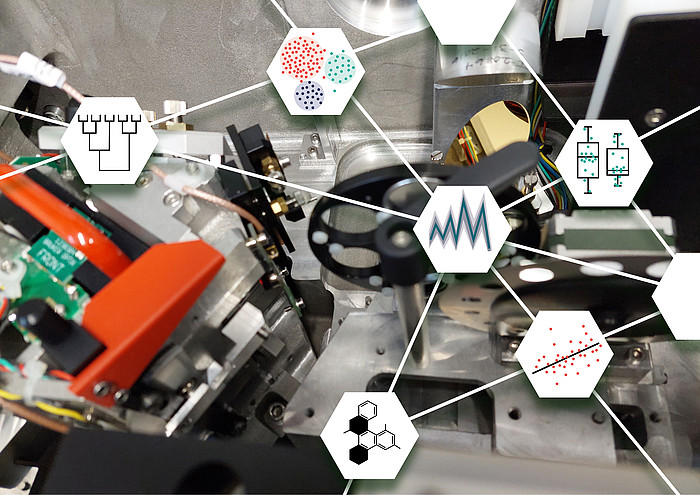FT-IR Spectroscopy
Surface enhanced infrared spectroscopy
The molecular structure of polymer boundary layers can be studied either to a very limited extent with conventional methods or cannot be studied at all. One reason for this is the very low thickness of the boundary layer. Non-linear optical methods, such as surface-enhanced infrared spectroscopy (SEIRA) or surface-enhanced Raman spectroscopy (SERS), enable significant amplification of molecular signals from the boundary layer.
For this purpose, metallic nanoparticles such as gold or silver are used to selectively amplify spectral information from the boundary layer. With the help of light, the free-moving metal electrons are set into oscillation. A so-called optical near field is created in which an enhanced interaction of the excited electrons with the surrounding medium occurs. This allows non-destructive insights into the molecular composition of the boundary layers.

Temperature controlled transmission - Thermocell
The monitoring or control of a chemical reaction represents a complex field in which , reaction control in a thermal cell during an in-situ FT-IR investigation makes it possible to elucidate chemical reaction mechanisms as well as to gain insight into time-dependent processes in boundary phases with different product compositions.

Multiple reflection ATR + flow cell
Particularly thin layers in the nano and micrometer range can either be measured with very low intensities or cannot be measured. Often, signals only become accessible through special measurement techniques such as SEIRA-IR spectroscopy. Another possibility is the application of a multiple ATR measurement principle. Through a large number of reflections on the surface of a silicon wafer, which can be used as an ATR crystal, an amplification of the analyte signal is observed.
An in-house designed flow cell enables the analysis of ultra-thin polymer films, interfacial and surface reactions or deposition process on surfaces.

Imaging and Multivariate Data Analysis
Infrared spectroscopic imaging enables the simultaneous recording of infrared spectra at different measuring points. Thus, local differences in chemical composition can be characterized and temporal changes at the respective measuring point can be detected. The amount of data that can be acquired is many times higher than with a single measurement and requires special evaluation methods. Multivariate data analysis tools have proven to be particularly suitable.
Equipment
FT-IR Spectrometer (Bruker Company)
- FT-IR Spectrometer Vertex 70v
- FT-IR Spectrometer Tensor 27
Measuring units FT-IR spectrometer
- Thermocell
- Directional, variable reflection unit 83° - 13°
- Multiple reflection ATR + flow cell
- FT-IR Microscope Hyperion 3000
- FT-IR Imaging IMAC
Metallization
- PVD deposition for gold and silver

